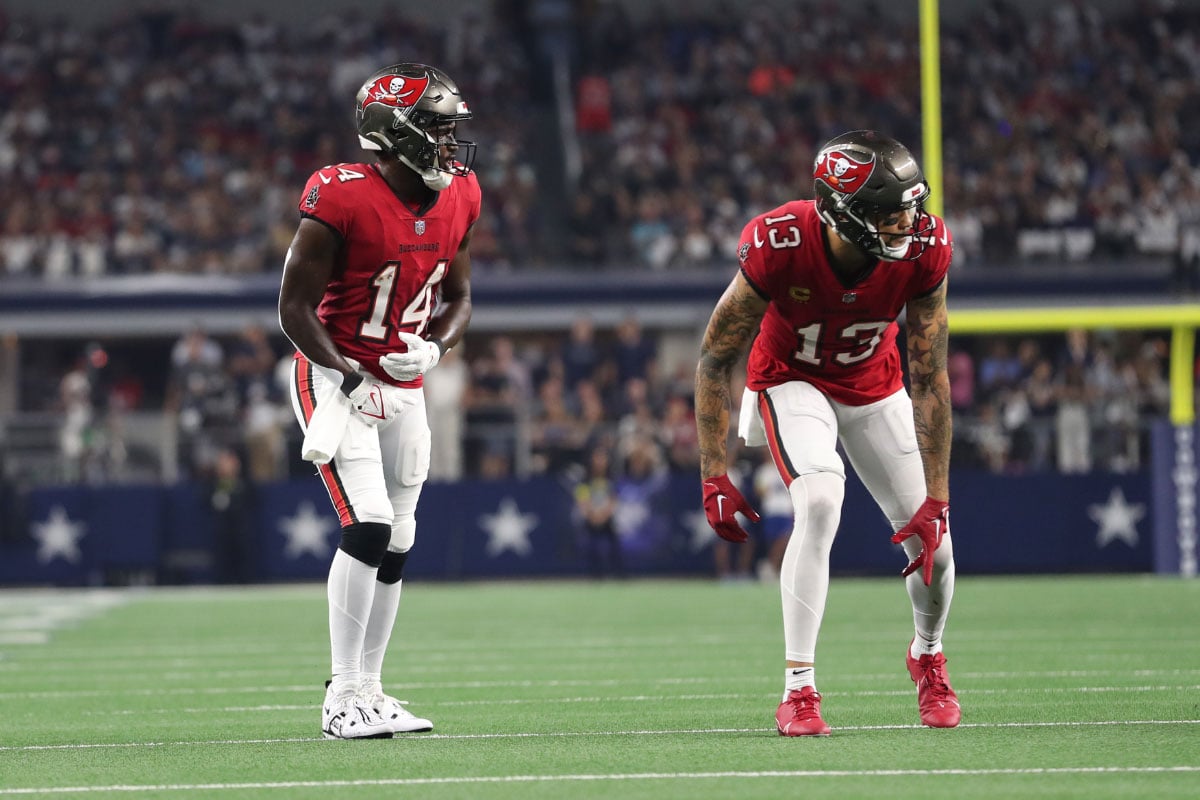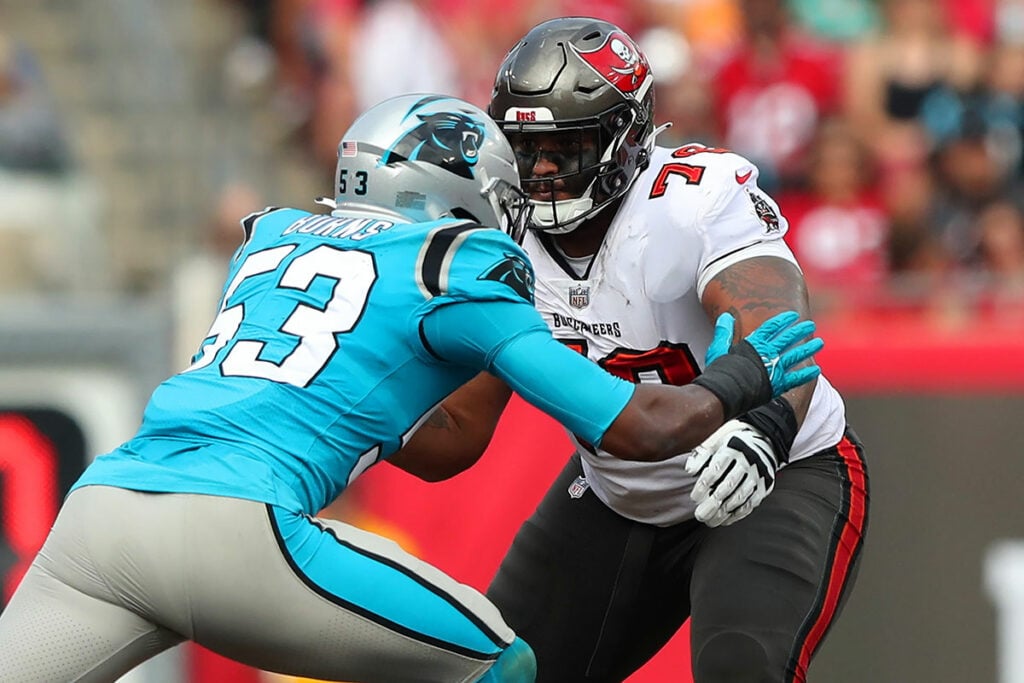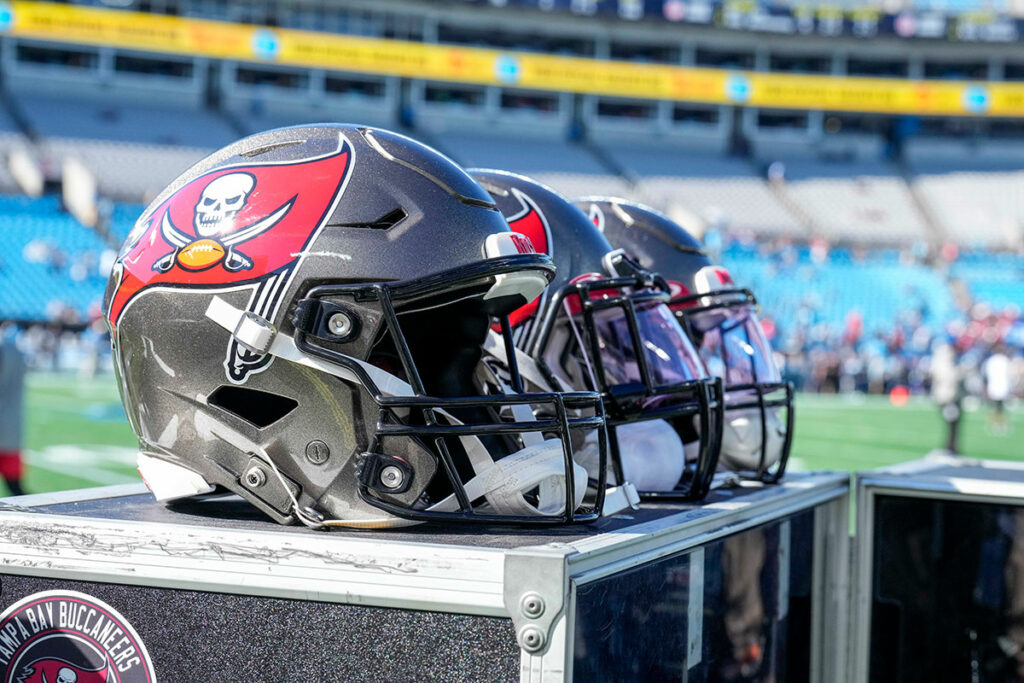Pewter Report analyzes each position’s strengths and weaknesses in Tampa Bay, as the Bucs attempt to three-peat as NFC South champions.
Next up is the wide receiver position, which is led by a pair of Pro Bowl-caliber receivers in Mike Evans and Chris Godwin. Gone is quarterback Tom Brady and the Bruce Arians offense, which featured a vertical-attack passing game. New offensive coordinator Dave Canales is installing a new system similar to Seattle’s, which features more crossing routes designed to create more yards-after-catch opportunities as well as some deep shots off play-action. Evans and Godwin will have a new quarterback throwing them the ball this year – either veteran Baker Mayfield or the unproven Kyle Trask.
Saddled with the league’s worst running game, the Bucs relied too heavily on their passing attack last year. Spotty pass protection led to too many quick passes from Brady to his receivers. Godwin’s receiving average fell from 11.3 yards per catch to 9.8 last season, while Russell Gage’s fell from 11.7 yards per catch in Atlanta in 2021 to 8.4 in Tampa Bay last year. So what’s in store for the Bucs receiver position in 2023?
The Strength of Bucs WRs: 1-2 Pro Bowl Punch
Tampa Bay is fortunate to have one of the league’s best receiver tandems in Mike Evans and Chris Godwin. The dynamic duo each topped the 1,000-yard mark for the third time together and are capable of doing that once more in Dave Canales’ new offense that he’s brought from Seattle. Both D.K. Metcalf and Tyler Lockett hit 1,000 yards receiving in 2022 and also in 2020. Evans is adept at stretching the field vertically, given his career 15.3-yard average. But this year, he should have the opportunity to get more run-and-catch opportunities with crossing routes.
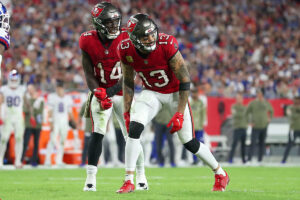
Bucs WRs Chris Godwin and Mike Evans – Photo by: Cliff Welch/PR
As long as he’s healthy, Evans should be in line for a 10th straight 1,000-yard season and perhaps another Pro Bowl. Getting him more targets inside the red zone is a must, as his touchdown production fell from a franchise-record 14 in 2021 to just six last year. More back-of-the-end zone fades and goal line screens would be wise calls for Canales to make.
Godwin is feeling even better this offseason one year removed from a torn ACL and should be in for a big season. He’s going to spend far more time outside than he did in the slot, which is where he’s primarily lined up since Bruce Arians’ arrival in 2019. Godwin has enough size and speed to win off the line of scrimmage and be a threat on the perimeter. More big plays down the field should resurrect his Pro Bowl chances.
Veteran Russell Gage has underwhelmed in Tampa Bay and been saddled with injuries. Last year, a hamstring injury robbed him of his quickness for most of the year and hurt his production. That led to Gage taking a $3 million pay cut. This offseason, Gage missed the OTAs and mini-camp with an undisclosed injury, which has been disappointing. Yet, rookie receivers Trey Palmer, Rakim Jarrett, Kade Warner and Ryan Miller have all had moments where they’ve shined in the offseason. Perhaps one of them can rise up and supplant Gage as the No. 3 receiver if he continues to be plagued with injuries or ineffectiveness.
Best-Case Scenario at WR
Evans and Godwin each post another 1,000-yard season and combine for 20 touchdowns or close to it like they did in 2021 (19), instead of the nine combined TDs they produced last year. Also, Gage rebounds with a better year and a young receiver or two also steps up to the plate.
The Weaknesses of Bucs WRs: Lack of Size and Proven Depth
Outside of Evans and Godwin, the Bucs’ receiver room lacks experience. Gone are veterans like Scotty Miller, Breshad Perriman and Julio Jones. Only Gage and newly signed David Moore have any real playing experience, so if Evans or Godwin get injured, it could really stall the Bucs’ passing game. Gage has experience, but has been unreliable due to injuries, and frankly not worth the $10 million per year that the Bucs initially invested in him. Moore is not a lock to make the team, as several young rookie receivers have looked good in OTAs and mini-camp.
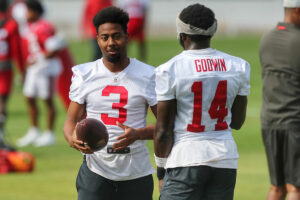
Bucs WRs Russell Gage and Chris Godwin – Photo by: Cliff Welch/PR
Not that the Bucs offense demands bigger receivers, but Evans is clearly the biggest at 6-foot-5, 225 pounds. The next tallest receivers are Godwin, Ryan Miller and Kade Warner, who are all just 6-fo0t-1 and weigh over 200 pounds. Evans’ long arms and wide catch radius have always help his quarterback’s completion percentage, especially in contested-catch situations. Should Evans get hurt, not only would Tampa Bay’s receiver room lack experience and play-making ability, but also some size.
With Evans, Godwin and Gage likely to be the top three receivers on the depth chart, the Bucs will keep two or three very young, inexperienced receivers to round out the unit. That’s a far cry from last year when Tampa Bay fielded a much bigger, very veteran unit with the 6-foot-4 Jones, the 6-foot-2 Perriman and Miller behind Evans, Godwin and Gage.
Worst-Case Scenario at WR
If either Evans or Godwin suffers a major injury, it would deeply affect the effectiveness of the wide receiver production in Tampa Bay. Both players staying healthy and producing 1,000-yard seasons is paramount to the Bucs’ chances of a three-peat in terms of winning the NFC South title.
Scott Reynolds is in his 30th year of covering the Tampa Bay Buccaneers as the vice president, publisher and senior Bucs beat writer for PewterReport.com. Author of the popular SR's Fab 5 column on Fridays, Reynolds oversees web development and forges marketing partnerships for PewterReport.com in addition to his editorial duties. A graduate of Kansas State University in 1995, Reynolds spent six years giving back to the community as the defensive coordinator/defensive line coach for his sons' Pop Warner team, the South Pasco Predators. Reynolds can be reached at: [email protected]

